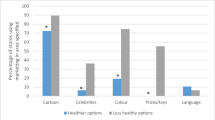Abstract
Adolescent obesity is a national public health problem, particularly among urban populations. Recent evidence has linked neighborhood food environments to health and nutrition status, with easier access to convenience stores being associated with increased risk for obesity. Little is known about the availability of healthy purchasing options within small, urban food stores, or the extent to which these factors are relevant to youth. The objective of this research was to characterize various features of the food environment within small convenience stores located nearby urban junior high and high schools. In-store audits were conducted in 63 stores located within 800 m of 36 urban Minnesota public secondary schools. Results indicated that a limited number of healthier beverages (i.e., water and 100% fruit juice) and snack options (i.e., nuts and pretzels) were available at most stores (≥85%). However, a wide range of healthy snack options were typically not available, with many specific items stocked in less than half of stores (e.g., low-fat yogurt in 27% of stores and low-fat granola bars in 43%). Overall, 51% of stores had fresh fruit and 49% had fresh vegetables. Few stores carried a range of healthier snack alternatives in single-serving packages. All stores had less healthful impulse purchase items available (e.g., candy) while only 46% carried healthier impulse items (e.g., fruit). Most stores (97%) had food/beverage advertising. Overall, convenience stores located in close proximity to secondary schools represent an important and understudied component of the youth food environment.
Similar content being viewed by others
References
Ogden CL, Carroll MD, Curtin LR, Lamb MM, Flegal KM. Prevalence of high body mass index in US children and adolescents. JAMA. 2010; 303(3): 242–249.
Morland K, Wing S, Diez Roux A. The Contextual effect of the local food environment on residents’ diets: the atherosclerosis risk in communities study. J Public Health. 2002; 92(11): 1761–1767.
Larson NI, Story MT, Nelson MC. Neighborhood environments: disparities in access to healthy foods in the U.S. Am J Prev Med. 2009; 36(1): 74–81.
Rose D, Hutchinson PL, Bodor JN, et al. Neighborhood food environments and body mass index. Am J Prev Med. 2009; 37(3): 214–219.
Andreyeva T, Blumenthal DM, Schwartz MB, Long MW, Brownell KD. Availability and prices of foods across stores and neighborhoods: the case of New Haven, Connecticut. Healthy Affairs. 2008; 27(5): 1381–1388.
Powell LM, Auld MC, Chaloupka FJ, O’Malley PM, Johnston LD. Associations between access to food stores and adolescent body mass index. Am J Prev Med. 2007; 33(4S): S301–S307.
Laska MN, Hearst MO, Forsyth A, Pasch KE, Lytle LA. Neighborhood food environments: are they associated with adolescent dietary intake, food purchases and weight status? Public Health Nutr. 2010; 13(11): 1757–1763.
Stice E, Shaw H, Marti CN. A meta-analytic review of obesity prevention programs for children and adolescents. Psychol Bull. 2006; 132(5): 667–691.
Gittlesohn J, Kumar MB. Preventing childhood obesity and diabetes: is it time to move out of the school? Pediatr Diab. 2007; 8(9S): 55–59.
Zenk SN, Powell LM. US secondary schools and food outlets. Health Place. 2008; 14: 336–346.
Chanil D. Profile of the convenience store customer. Conven Store News. 2002; 24(2): 53.
Borradaile KE, Sherman S, Vander Veur SS, et al. Snacking in children: the role of urban corner stores. Pediatrics. 2009; 124(5): 1293–1298.
Wang YC, Gortmaker SL, Sobol AM, Kuntz KM. Estimating the energy gap among US children: a counterfactual approach. Pediatrics. 2006; 118(6): e1721–e1733.
Wardlaw GM, Hampl JS, DiSilvestro RA. Perspectives in nutrition. 6th ed. New York, NY: McGraw Hill; 2004.
Khan LK, Sobush K, Keener D, et al. Recommended community strategies and measurements to prevent obesity in the United States. MMWR. 2009; 58(7): 1–26.
Laska MN, Borradaile KE, Tester J, Foster GD, Gittlesohn J. Healthy food availability in small urban food stores: a comparison of four US cities. Public Health Nutr. 2009; 8: 1–5.
United States Census Bureau. North American Industry Classification System. http://www.census.gov/cgi-bin/sssd/naics/naicsrch?code=445120&search=2007%20NAICS%20Search. Accessed April 5, 2010.
Acknowledgments
The authors would like to thank the Robert Wood Johnson Foundation’s Health Eating Research Corner Store Working Group for their input and collaboration on development various components of the data collection tool, particularly Drs. Kelley Borradaile, June Tester, Gary Foster, and Joel Gittelsohn. In addition, the authors would like to thank David Van Riper, MS (University of Minnesota Population Center) for conducting the GIS analysis. Salary support for Dr. Laska was provided by the National Cancer Institute (NCI) (K07CA126837, PI: M.N. Laska). The content of this manuscript does not necessarily represent the off?cial views of the NCI. The NCI did not play a role in designing the study, collecting the data, or analyzing/interpreting the results.
Author information
Authors and Affiliations
Corresponding author
Rights and permissions
About this article
Cite this article
Gebauer, H., Laska, M.N. Convenience Stores Surrounding Urban Schools: An Assessment of Healthy Food Availability, Advertising, and Product Placement. J Urban Health 88, 616–622 (2011). https://doi.org/10.1007/s11524-011-9576-3
Published:
Issue Date:
DOI: https://doi.org/10.1007/s11524-011-9576-3



